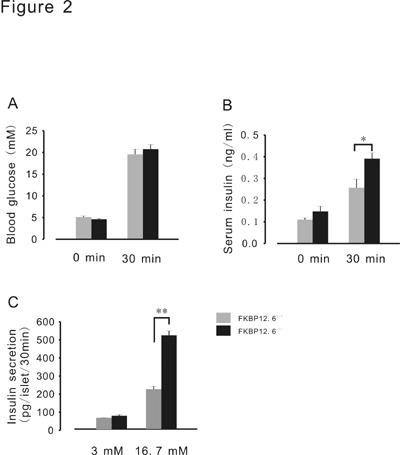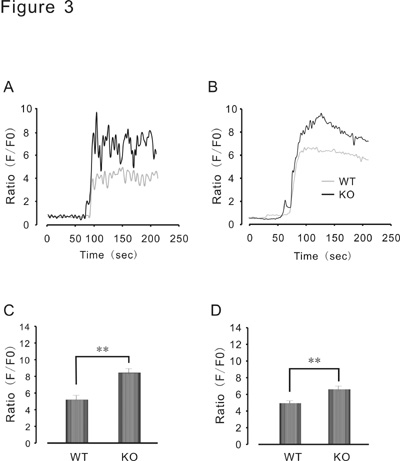FKBP12.6: a novel regulator for glucose-stimulated insulin secretion
FK506 binding protein 12.6 kDa (FKBP12.6) is a protein that regulatesryanodine Ca2+ release channels, and is thought to be an important regulatorof insulin secretion. The nature and mechanism of its involvement in regulating glucose metabolism, however, are not well understood. Research from the labs of Professor Guangju Ji and Professor Tao Xu, published recently in The FASEB Journal, sheds light on the involvement of FKBP12.6 and ryanodine receptors in insulin secretion and glucose metabolism. Their results have firmly established a direct role for FKBP12.6/RyR2 in regulating glucose-stimulated Ca2+ oscillation and glucose-stimulated insulin secretion in pancreatic islets.
The role of FKBP12.6 inthe control of insulin secretion and blood glucose was clarifiedusing FKBP12.6–/– mice. In these studies, FKBP12.6–/– mice showed significant fed hyperinsulinemia but exhibited normoglycemia,fasting normoinsulinemia, and normal body weight compared withwild-type littermate control mice. Deletion of FKBP12.6resulted in enhanced glucose-stimulated insulin secretion both in vivo and in vitro, due to enhancedglucose-induced Ca2+ elevation in pancreatic islets. After a high-fat dietarychallenge for 3 months, FKBP12.6–/– mice displayedhigher body weights, hyperinsulinemia, and lower fed blood glucoseconcentrations compared with wild-type mice. FKBP12.6–/– mice displayed hyperinsulinemia, and resistance to high-fat diet-inducedhyperglycemia, suggesting that FKBP12.6 plays an important rolein insulin secretion and blood glucose control, and raisingthe possibility that it may be a potential therapeutic targetfor the treatment of type 2 diabetes.

Figure 2. Deletion of FKBP12.6 results in enhanced insulin secretion.
A and B: Blood glucose and serum insulin levels in FKBP12.6-/- mice (n=6) and control littermates (n=6) injected with glucose (3g/kg body weight i.p.). Blood was collected before (0 min) and 30 min after glucose injection. At 30 min after glucose application, a significant increase in serum insulin levels (B) was observed in FKBP12.6-/- mice, while the blood glucose levels (A) were similar between KO and control littermates. C: Glucose-stimulated insulin secretion from isolated islets. Following overnight culture, fifteen islets were exposed to 3mM glucose for 1 hour as basal insulin secretion, and then exposed to 16.7mM glucose for 30min. Insulin concentrations were determined by ELISA. N=6 mice for each group. * P<0.05, ** P<0.01.

Figure 3 Enhanced Ca2+ response to glucose or KCl application in isolated FKBP12.6-/- islets.
A and B: The response of Ca2+ to glucose application (16.7mM) in FKBP12.6-/- islets and control islets. C and D: The response of Ca2+ to KCl application (25mM) in FKBP12.6-/- islets and control islets. n=15-20 islets for each group. ** P<0.01.

